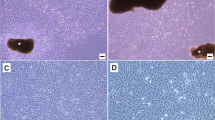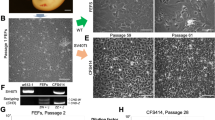Abstract
Cetaceans are specialized marine mammals with a unique respiratory system adapted for diving behavior. Furthermore, respiratory diseases are commonly observed in these mammals. Nevertheless, much of their respiratory physiology remains unknown due to the limited supply and poor quality of their biological samples for research. In this study, we established a novel lung cell line, dLu, derived from the common bottlenose dolphin (Tursiops truncatus), which can prove useful in cetacean research, including for understanding the pathogenesis of respiratory diseases in cetaceans. The cells were cultured in a simple medium consisting of Dulbecco’s modified Eagle’s medium supplemented with 10% fetal bovine serum. The morphology of the cells was fibroblast-like. dLu was produced by transfecting the simian virus 40 large T antigen into primary cultured cells. Although dLu exhibited approximately 80 cell divisions, it was unable to achieve complete immortalization, as the cells stopped proliferating beyond this number. dLu cells expressed toll-like receptor 3 but not toll-like receptor 4. Immunostimulation with poly(I:C) altered the gene expressions of interferon beta 1 and tumor necrosis factor alpha in dLu cells. In summary, dLu established in this study is a novel cetacean cell resource that can be easily cultured and is a useful in vitro tool in cetacean research, particularly for studying host immune responses in the lungs.





Similar content being viewed by others
References
Alexopoulou L, Holt AC, Medzhitov R, Flavell RA (2001) Recognition of double-stranded RNA and activation of NF-κB by toll-like receptor 3. Nature 413:732–738
Barron SL, Saez J, Owens RM (2021) In vitro models for studying respiratory host–pathogen interactions. Adv Biol 5. https://doi.org/10.1002/adbi.202000624
Beineke A, Siebert U, Wohlsein P, Baumgärtner W (2010) Immunology of whales and dolphins. Vet Immunol Immunopathol 133:81–94. https://doi.org/10.1016/j.vetimm.2009.06.019
Burkard M, Whitworth D, Schirmer K, Nash SB (2015) Establishment of the first humpback whale fibroblast cell lines and their application in chemical risk assessment. Aquat Toxicol 167:240–247. https://doi.org/10.1016/j.aquatox.2015.08.005
Carvan MJ, Santostefano M, Safe S, Busbee D (1994) Characterization of a bottlenose dolphin (Tursiops truncatus) kidney epithelial cell line. Mar Mam Sci 10(1):52–69. https://doi.org/10.1111/j.1748-7692.1994.tb00389.x
Fridman AL, Tainsky MA (2008) Critical pathways in cellular senescence and immortalization revealed by gene expression profiling. Oncogene 27:5975–5987. https://doi.org/10.1038/onc.2008.213
Garrick RA, Woodin BR, Wilson JY, Middlebrooks BL, Stegeman JJ (2006) Cytochrome P4501A is induced in endothelial cell lines from the kidney and lung of the bottlenose dolphin, Tursiops truncatus. Aquat Toxicol 76:295–305. https://doi.org/10.1016/j.aquatox.2005.10.005
Harasawa R, Mizusawa H, Nozawa K, Nakagawa T, Asada K, Kato I (1993) Detection and tentative identification of dominant mycoplasma species in cell cultures by restriction analysis of the 16S–23S rRNA intergenic spacer regions. Res Microbiol 144:489–493. https://doi.org/10.1016/0923-2508(93)90057-9
Ishengoma E, Agaba M (2017) Evolution of toll-like receptors in the context of terrestrial ungulates and cetaceans diversification. BMC Evol Biol 17:54. https://doi.org/10.1186/s12862-017-0901-7
Iwasaki A, Medzhitov R (2004) Toll-like receptor control of the adaptive immune responses. Nat Immunol 5:987–995. https://doi.org/10.1038/ni1112
Jha KK, Banga S, Palejwala V, Ozer HL (1998) SV40-mediated immortalization. Exp Cell Res 245(1):1–7. https://doi.org/10.1006/excr.1998.4272
Jin W, Jia K, Yang L, Chen J, Wu Y, Yi M (2013) Derivation and characterization of cell cultures from the skin of the Indo-Pacific humpback dolphin Sousa chinensis. Vitr Cell Dev Biol - Anim 49:449–457. https://doi.org/10.1007/s11626-013-9611-7
Kawasaki T, Kawai T (2014) Toll-like receptor signaling pathways. Front Immunol 5. https://doi.org/10.3389/fimmu.2014.00461
Kooyman GL (1973) Respiratory adaptations in marine mammals. Integr Comp Biol 13:457–468. https://doi.org/10.1093/icb/13.2.457
Longo PA, Kavran JM, Kim MS, Leahy DJ (2014) Single cell cloning of a stable mammalian cell line, 1st edn. Elsevier Inc.
McFee WE, Lipscomb TP (2009) Major pathologic findings and probable causes of mortality in bottlenose dolphins stranded in South Carolina from 1993 to 2006. J Wildl Dis 45:575–593. https://doi.org/10.7589/0090-3558-45.3.575
Nagasawa T, Uemori T, Asada K, Harasawa R (1992) Acholeplasma laidlawii has tRNA genes in the 16S–23S spacer of the rRNA operon. J Bacteriol 174(24):8163–8165. https://doi.org/10.1128/jb.174.24.8163-8165.1992
Palumbi S, Martin A, Romano S, McMillan WO, Stice L, Grabowski G (1991) The simples fool’s guide to PCR. University of Hawaii, Honolulu
Pine M, Schroeder M, Greer K, Hokanson R, Busbee D (2004) Generation and partial characterization of a transformed cetacean cell line. Aquat Toxicol 67(2):195–202. https://doi.org/10.1016/j.aquatox.2004.01.003
Piscitelli MA, Raverty SA, Lillie MA, Shadwick RE (2013) A review of cetacean lung morphology and mechanics. J Morphol 274:1425–1440. https://doi.org/10.1002/jmor.20192
Poltorak A, He X, Smirnova I, Liu M-Y, Van Huffel C, Du X, Birdwell D, Alejos E, Silva M, Galanos C, Freudenberg M, Ricciardi-Castagnoli P, Layton B, Beutler B (1998) Defective LPS signaling in C3H/HeJ and C57BL/10ScCr mice: mutations in Tlr4 gene. Science (80-) 282:2085–2088. https://doi.org/10.1126/science.282.5396.2085
Rosel PE, Dizon AE, Heyning JE (1994) Genetic analysis of sympatric morphotypes of common dolphins (genus Delphinus). Mar Biol 119:159–167. https://doi.org/10.1007/BF00349552
Sitt T, Bowen L, Blanchard MT, Smith BR, Gershwin LJ, Byrne BA, Stott JL (2008) Quantitation of leukocyte gene expression in cetaceans. Dev Comp Immunol 32:1253–1259. https://doi.org/10.1016/j.dci.2008.05.001
Suttle CA (2007) Marine viruses - major players in the global ecosystem. Nat Rev Microbiol 5:801–812. https://doi.org/10.1038/nrmicro1750
Suzuki M, Wakui H, Itou T, Segawa T, Inoshima Y, Maeda K, Kikuchi K (2016) Two isoforms of aquaporin 2 responsive to hypertonic stress in the bottlenose dolphin. J Exp Biol 219:1249–1258. https://doi.org/10.1242/jeb.132811
Takeda K, Akira S (2005) Toll-like receptors in innate immunity. Int Immunol 17:1–14. https://doi.org/10.1093/intimm/dxh186
Tashiro K, Segawa T, Futami T, Suzuki M, Itou T (2023) Establishment and characterization of a novel kidney cell line derived from the common bottlenose dolphin. Vitr Cell Dev Biol Anim. https://doi.org/10.1007/s11626-023-00786-y
Tovey MG, Streulit M, Gressert I, Gugenheim J, Blanchardt B, Guymarhot J, Vignauxt F, Gigou M (1987) Interferon messenger RNA is produced constitutively in the organs of normal individuals. Proc Natl Acad Sci U S A 84:5038–5042. https://doi.org/10.1073/pnas.84.14.5038
Venn-Watson S, Daniels R, Smith C (2012) Thirty year retrospective evaluation of pneumonia in a bottlenose dolphin Tursiops truncatus population. Dis Aquat Organ 99:237–242. https://doi.org/10.3354/dao02471
Xu S, Tian R, Lin Y, Yu Z, Zhang Z, Niu X, Wang X, Yang G (2019) Widespread positive selection on cetacean TLR extracellular domain. Mol Immunol 106:135–142. https://doi.org/10.1016/j.molimm.2018.12.022
Yajing S, Rajput IR, Ying H, Fei Y, Sanganyado E, Ping L, Jingzhen W, Wenhua L (2018) Establishment and characterization of pygmy killer whale (Feresa attenuata) dermal fibroblast cell line. PLoS ONE 13:1–15. https://doi.org/10.1371/journal.pone.0195128
Yu J, Kindy MS, Ellis BC, Baatz JE, Peden-Adams M, Ellingham TJ, Wolff DJ, Fair PA, Gattoni-Celli S (2005) Establishment of epidermal cell lines derived from the skin of the Atlantic bottlenose dolphin (Tursiops truncatus). Anat Rec A Discov Mol Cell Evol Biol 287A:1246–1255. https://doi.org/10.1002/ar.a.20266
Zhou P, Tachedjian M, Wynne JW, Boyd V, Cui J, Smith I, Cowled C, Ng JHJ, Mok L, Michalski WP, Mendenhall IH, Tachedjian G, Wang LF, Baker ML (2016) Contraction of the type i IFN locus and unusual constitutive expression of IFN-α in bats. Proc Natl Acad Sci U S A 113:2696–2701. https://doi.org/10.1073/pnas.1518240113
Acknowledgements
We sincerely thank the cooperation of the Taiji Fisheries Cooperative Union (Wakayama, Japan) and the Fisheries Agency of Japan for providing the specimen used in this study. We would also like to thank the staff of the Shinagawa Aquarium for their assistance in collecting the blood samples used in this study.
Funding
This work was supported by a research grant from the Strategic Research Base Development Program, “International Joint Research and Training of Young Researchers for Zoonosis Control in a Globalized World.”
Author information
Authors and Affiliations
Contributions
Kaede Tashiro: conceptualization, methodology, investigation, visualization, writing—original draft, writing—review and editing. Kyosuke Hikobe: methodology, investigation, formal analysis. Takao Segawa: conceptualization, methodology, investigation. Miwa Suzuki: investigation, resources. Ken Maeda: resources, methodology. Takuya Itou: conceptualization, methodology, project administration. All authors read the manuscript and approved the final submitted manuscript for publication.
Corresponding author
Ethics declarations
Conflict of interest
The authors declare no competing interests.
Rights and permissions
Springer Nature or its licensor (e.g. a society or other partner) holds exclusive rights to this article under a publishing agreement with the author(s) or other rightsholder(s); author self-archiving of the accepted manuscript version of this article is solely governed by the terms of such publishing agreement and applicable law.
About this article
Cite this article
Tashiro, K., Hikobe, K., Segawa, T. et al. Establishment and characterization of a novel lung cell line derived from the common bottlenose dolphin. In Vitro Cell.Dev.Biol.-Animal 60, 98–105 (2024). https://doi.org/10.1007/s11626-023-00831-w
Received:
Accepted:
Published:
Issue Date:
DOI: https://doi.org/10.1007/s11626-023-00831-w




